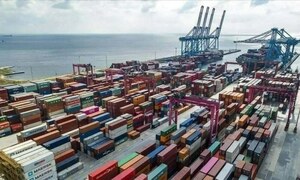The last 100 years (1905-2004) investigative study of siesmic data, carried out at Sir Syed University of Engineering and Technology (SSUET), has established that Karachi is not located in an earthquake belt. The details of this study were released by SSUET in a report recently.
However, according to SSUET's study, Karachi is within the realm of perceptibility of earthquake shocks occurring in seismic belts of neighbouring regions like Murray Ridge, PAB-Kirthar Range Sarjani - Jhampir, Mekran Coast and Rann of Kutch. In the last 100 years, the study said, 104 earthquakes with magnitudes ranging between 3.00 and 8.5 on Richter Scale occurring on these faults were felt at Karachi, but their effective intensity at Karachi was less than "6" on modified Mercalli Scale which normally does not cause any damage to buildings and structures.
Regarding occasional shaking of coastal region of Karachi, it is a normal feature, it added.
For coastal developments, large scale filling of vast areas, hundreds of meters deep extending over tens of kilometers, takes place over long period with loose earth, soil, mud, sand, etc. The filling up of vast coastal region along Karachi belt started in 1920s when Karachi was declared a port and has continued continuously along District South where big networks like Steel Mill, Naval HQs, Industrial Estates, Defence Housing Society, Clifton, etc have developed in due course.
According to the study, it is a known and recognised geologic phenomenon that in course of time these alluvial soil compress into solid rock and continue to move down gradually causing minor surface shaking which should not be construed as earthquake.
Such occasional shakings not discernible on seismograms as has happened on many occasions during the last several months. Earthquakes of even small magnitudes 2 and 3 are recorded by Pakistan met department's seismographs at Quetta and Peshawar.
However, it is pertinent to mention that Murray Ridge Area located about 100 to 150-km south-west of Karachi is an active seismic region, and even minor shocks occurring in Murray Ridge will be mildly perceptible along the coastal region, but will not be felt further up in vast areas of the city, the SSUET study said.
BR100
11,819
Decreased By
-47.3 (-0.4%)
BR30
35,728
Increased By
30.6 (0.09%)
KSE100
113,599
Decreased By
-549.9 (-0.48%)
KSE30
35,751
Decreased By
-201.2 (-0.56%)

























Comments
Comments are closed.